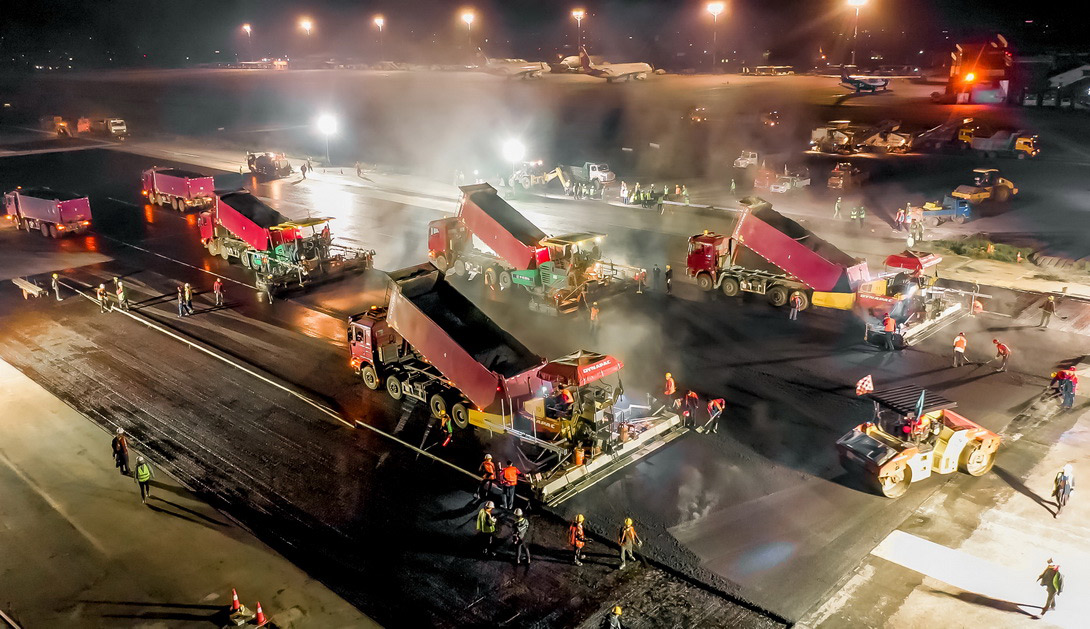TIA | Rehabilitation project | Runway | Taxiway

The Tribhuvan International Airport (TIA) has been shutting down for 10 hours daily, suspending all flights between 10 PM and 8 AM from November 8 until next year’s March end. The reason is upgradation works in the airport’s sensitive area, which makes up 75 metres radius of the runway.
These upgradation works include parallel taxiways, international aprons and hangar aprons.
A parallel taxiway serves as a separate path for aircraft movement, linking runways to key areas like aprons, hangars, and terminals. The infrastructure boosts runway capacity and enhances the overall efficiency and flexibility of the aerodrome.
Two parallel taxiways are under construction at the moment.
The existing parallel taxiway at the TIA is just 110 metres from the runway. This will now be developed 172.5 metres southwest of the runway based on International Civil Aviation Organisation (ICAO) standards and will span 1,140 metres.
Another taxiway will be built north of the runway spanning 450 metres.
The planned parallel taxiways are expected to reduce air congestion — the problem of holding airplanes in the air causing significant disruptions at the TIA.
Additionally, eight new exit taxiways will be added to enhance runway capacity. An exit taxiway is a designated path that enables aircraft to exit the runway and continue toward the terminal building.
Similarly, the existing international apron is also being expanded to the north increasing parking capacity from 11 to 18 aircraft, and reducing flight delays. International apron is where aircraft are parked, loaded, unloaded, refueled, and boarded by passengers.
While the hangar apron to the east will include a taxiway for maintenance operations, improving logistical efficiency. The hangar apron is where the aircraft are housed and repaired and maintained when not in use.
Work beyond the sensitive area at the TIA has been going on for over three and a half years in three shifts throughout 24 hours. The only runway at TIA was expanded to 3,350 metres from 3,050 metres on the southern exit earlier in 2019.
The current expansion is part of the South Asia Sub Regional Cooperation (SASEC) Airport Capacity Enhancement Project, which aims to improve the infrastructure and operational capacity of the TIA and the Gautam Buddha International Airport (GBIA).
Alongside TIA airside facilities, the project includes the construction of a new international terminal building at the GBIA using solar panels and energy-efficient lighting and designing the next phase capacity development of the TIA.
The total project budget is $198 million. Of this, $48 million is funded by the Nepal government, while the remaining $150 million is financed by the Asian Development Bank (ADB) as a concessional loan. The agreement was signed between the Nepal government and the ADB in Dec 2020.
The ongoing civil construction work is contracted to a joint venture between KDN Airport Engineering and China Civil Engineering Construction Corporation (CCECC), which is responsible for the parallel taxiway. Gansu Mechanized Construction Engineering is responsible for the hangar and aprons.
The project is expected to be completed by December 31, 2026.
Read More Stories
Kathmandu’s decay: From glorious past to ominous future
Kathmandu: The legend and the legacy Legend about Kathmandus evolution holds that the...
Kathmandu - A crumbling valley!
Valleys and cities should be young, vibrant, inspiring and full of hopes with...
Nepal to receive $36.1 million to mitigate GLOF risks
Nepal is set to receive $36.1 million in mitigating one of the escalated...